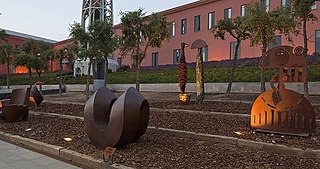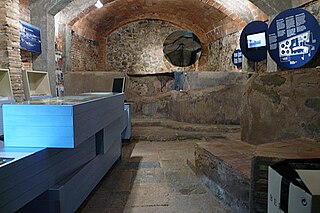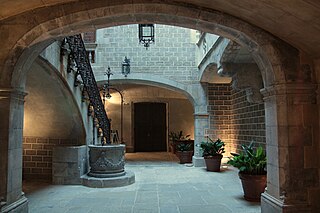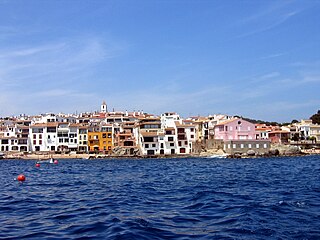
Ampurdan or Emporda is a natural and historical region of Catalonia, Spain, divided since 1936 into two comarques, Alt Empordà and Baix Empordà.

The Castle of Púbol, located in Púbol in the comarca of Baix Empordà, Girona, Catalonia, is a medieval building where the surrealist painter Salvador Dalí's enormous creative efforts were focused on a single person, his wife Gala, with the aim of providing her with a unique sanctuary and resting place. In this sense, Gala is buried at the castle.

The Costa Brava is a coastal region of Catalonia in northeastern Spain, consisting of the comarques (counties) of Alt Empordà, Baix Empordà and Selva in the province of Girona. Costa Brava stretches from the town of Blanes, 60 km (37 mi) northeast of Barcelona, to the French border. In the 1950s, the Costa Brava was identified by the Spanish government and local entrepreneurs as being suitable for substantial development as a holiday destination, mainly for package holiday tourists from Northern Europe and especially, the United Kingdom and France. The combination of a very good summer climate, nature, excellent beaches and a favourable foreign exchange rate before the creation of the single European currency, which made Costa Brava an attractive tourist destination, was exploited by the construction of large numbers of hotels and apartments in such seaside resorts as Blanes, Tossa de Mar and Lloret de Mar. Tourism rapidly took over from fishing as the principal business of the area.

The Fundació Joan Miró, Centre d'Estudis d'Art Contemporani is a museum of modern art honoring Joan Miró located on the hill called Montjuïc in Barcelona, Catalonia (Spain).
Dau al Set, the first post-World War II artistic movement in Catalonia, was founded in Barcelona in September 1948 by poet Joan Brossa. The movement, best known for translating the conscious and unconscious mind into art, was heavily influenced by both the Surrealist and Dadaist movements. In Catalan Dau al Set means "the seventh face of the dice", which expresses the movement's rupturist character.

Joan Brossa was a Catalan poet, playwright, graphic designer and visual artist. He wrote only in the Catalan language.

The Fundació Vila Casas, founded in 1986 by the pharmaceutical entrepreneur Antoni Vila Casas, is a private, non-profit making organisation which has the promotion of contemporary Catalan art as its main aim.

Can Framis is the latest Fundació Vila Casas museum, an art center devoted to the promotion of contemporary Catalan painting. Located in the old Can Framis factory complex, the museum displays more than 250 paintings from the sixties to the present made by artists born or currently living in Catalonia. In addition to the permanent collection which is divided in three floors, Can Framis Museum has an area dedicated to temporary exhibitions named Espai Aø. The permanent collection is updated periodically, and two new temporary exhibitions are opened every three months.

The Palau Solterra houses the Contemporary Photography Museum of the Fundació Vila Casas located in the town of Torroella de Montgrí in the Baix Empordà region of Catalonia. It was opened in 2000.

Can Mario Museum is the Fundació Vila Casas Museum of Contemporary Sculpture in Palafrugell. It was opened in 2004. It has around 220 works on show dating from the 1960s to the present day by a wide range of artists born or living in Catalonia. Temporary exhibitions are also held every year.

The Museum of the Mediterranean is a museum located in Torroella de Montgrí, founded in 2003, in an attempt to become an area for knowledge, reflection and research for the problems and worries that affect citizens in the 21st century. It is housed in Can Quintana, a 16th-century building. It is dedicated to the knowledge and communication of the Mediterranean Sea and uses the natural sounds, human sounds and music to show the reality of the land, the history and the culture of the village of Torroella, connected with the others Mediterranean cultures and towns. It pretends to become a site to think about the nearest territory and the main issues that affect the different Mediterranean nations.

The Cork Museum of Palafrugell, Spain, was created in 1972 in order to acquire, conserve, interpret and value the heritage around the cork industry in Catalonia. The cork industry has been influenced the landscape, the life and the identity of this Catalan area. The Cork Museum is part of the Costa Brava Museum Network and the Network of Local Museums of Catalonia in the demarcation of Girona.

The Carmen Thyssen Space is an art gallery in the municipality of Sant Feliu de Guíxols, in the Baix Empordà region. containing works from the Carmen Thyssen Collection. Her commitment to promoting culture lends special relevance to the family activities that accompany the artwork on display.

The Josep Pla Foundation is a literary heritage center that focuses on promoting the reading and study of the literary and journalistic work of Josep Pla. The foundation is located in the writer's hometown, in Palafrugell, where you can see temporary exhibitions and the permanent exhibition "Josep Pla (1897-1981)" that explains his professional career in the historical context of the 19th century.

The Mascort Foundation is a private foundation located in the municipality of Torroella de Montgrí, in the Baix Empordà region, created in 2007 by Ramon Mascort Amigó, current president of the entity. This foundation was created thanks to his passion for art and collecting, as well as for his interest in the photography. Its first headquarter was the Casa Galibern, the old house of the maternal grandmother.

Ca la Pruna is a 16th-century fortified house, in the town of Pals. It is included in the Inventory of the Architectural Heritage of Catalonia.
The House of Magic, located in a Catalan farmhouse dated from 1850 in the municipality of Santa Cristina d'Aro, is a cultural facility inaugurated in 2002 and managed by Xavier Sala i Costa, internationally known in the world of ilusionism by Xevi.

Sa Perola is a net dyeing house of the Fisherman's Guild at Saint Piere. It is located in Carrer de les Voltes de Calella de Palafrugell. The documentation was preserved by the same producer until his entrance to the Municipal File of Palafrugell.

The Palau Solterra Museum is one of the cultural centers of the Vila Casas Foundation located, located in the palace of the same name in Torroella de Montgrí (Girona), a town of the Baix Empordà region. It opened in 2000, and nowadays it houses about three hundred contemporary photographs of the city, artists from various parts of the world, including Chema Madoz, Alberto García Álix, Toni Catany, Otto Lloyd, Xavier Miserachs, Ouka Lele and Frank Horvat, among many others.




















